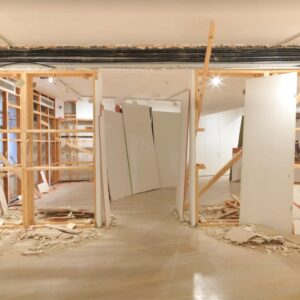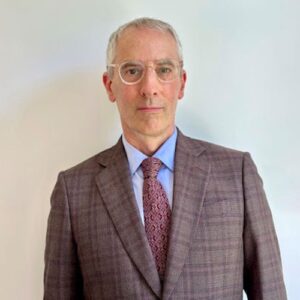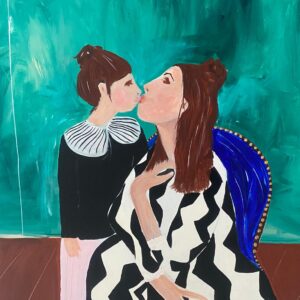
1. When did you start to make art?
From an early age, I enjoyed walking and exploring the peak district, and often collected
interesting bits and pieces I would find. During my A-levels (1990-92) I started
incorporating these found objects in my sculpture. The first work made entirely from
found objects was a “figurative” sculpture of an elderly person. It wasn’t planned, but
inspired by a unusual piece of rhododendron, which was very evocative, though contorted
and arthritic, of a human skeleton, complete with hips, thighs, and spine. The “head” was
a weathered tree root with expressive features and a crown of mossy hair, with bestial
horns poking through. I sat the work on an old Thonet chair, and propped up an
outstretched arm with a walking stick. Although created by accident and intuition, it
resonated with ideas of our resistance to aging and nature. At this point I began to realize
that nature could be an ally in making art.
2. How did you evolve into a professional artist?
In the summer before going to University, I produced a series of environmental artworks;
rather than collecting materials to take home, I decided to work with them where they
were found. They were created without a plan and without tools. I quickly developed an
approach of minimal intervention and humility, of finding ways to relate to the landscape
without spoiling it.
The process of walking and hunting for the right places and objects to work with, of total
immersion in the environment, was a form of meditation; the distinction between
humanity and nature became meaningless, as did the boundary between the work and
the landscape. These experiences allowed me to develop a deeper understanding of both
human and natural creativity.
At this point, I had already decided that I needed no formal training in art, and chose a
degree in mathematics, having briefly flirted with the idea of being an architect. During
my degree, I took an optional Fine Art module, and produced a series of sculptures called
Manifold 1 using copper piping (the sort used in domestic central heating), which explored
the intrinsic geometry of this industrial system. The change from natural to industrial
objects paralleled my move from a rural to an urban environment.
Ultimately I did not want to pursue maths as a career, but nor was I inspired to become a
fine artist. I felt, and still feel, that the art world profits from maintaining a thin veneer of
pseudo intellectualism, which obscures its increasing irrelevance to society. Art has
become a primarily commercial product, relying on alienation and insecurity to promote
desire.
I decided to pursue Design, as a less hubristic way to satisfy both my sculptural and
rational interests. I see no significant distinction between art and design and approach
both with the same mindset. Both are compositions of objects in space. Both are problem
solving, albeit with slightly different problems. Function is just another rule to consider in
the creative process. Design is functional sculpture. Decoration can be thoughtful as well
as beautiful.
Having spent the last 12 years being sidetracked by running a photographic studio (a long
story), Manifold 2 represents my first project as a “professional” artist/designer.
3. What drove you to make art as a professional vocation?
Each work of art modifies the definition of what “Art” is. I am motivated to contribute to
this definition, and to explore the convergence between art and design. To me this
convergence is about showing that art need not be obsessively intellectual and
conceptual, that there should be no hard boundary between the decorative and functional
aspects of our environment, and that this environment can be intellectually stimulating.
However, I would not define myself as a professional artist. I am ambivalent about art;
Whilst compelled to make it, I cannot make the case that it is, in any objective sense,
important, and it will never be the only thing I do. If I thought that art was a suitable
vehicle for political/social/environmental protest, then perhaps I would think differently;
but it isn’t – political art is neither effective politics or effective art. We face too many
problems as a society that must be dealt with directly to be merely an artist.
In more general terms, while specialism in a particular profession is often a source of
innovation, it also leads to a loss of holistic thinking. Through a steady process of
industrialization and globalization, our civilization has become a complex system of
interdependent specialists. The apparent stability of this system has been propped up by
an abundance of oil. As we pass peak oil into energy descent, we may all have to take
increasing responsibility for the products and services we rely on, and become more
generalists than specialists.
Our obsession with career and success can be corollated to both social and environmental
degradation. To create a sustainable and sustaining society, we will need to break this
obsession, and engage in activities that do not involve pay, but that help to rebuild our
social and environmental capital.
4. Explain your inspiration?
Nature and Mathematics are the most important sources of inspiration. Nature, as the
ultimate source of creation, the master builder, the preeminent innovator of form and
function. Mathematics is a highly structured system of thought which strips ideas back to
their underlying axioms or assumptions to see how they work, before developing them to
their logical conclusions. And yet, despite its unassailable logic, it is a highly intuitive and
creative field; Like science, it often uses beauty as a method of detecting, if not proving,
truth.
Many of my ideas are to do with patterns in the geometry of my chosen objects. There
are many variables that come into play with this geometry; rather than producing a single
optimal solution, I prefer to explore in a series how the geometry performs under
repetition and variation.
In a sense my work is about identity. Many artists work is a definitive stamp of their own
identity, their authority over their subject; whereas I employ various strategies to remove
my identity from the artwork; I choose to work with objects that have their own identity,
and which dictate the ways in which they can be composed, such as Treen and Manifold
1. I also impose rules and constraints in order to delegate responsibility, such as with
Manifold 2, which restricts the design process to cutting and folding of square sheets. All
my chosen objects are the products of complex systems, whether natural, industrial or
mathematical.
5 In what way does your inspiration transform into ideas?
I have no prescribed method for generating ideas. I am not an industrial product designer,
driven by a need to fulfill, or problem to solve. Nor am I an artist labouring to create a
towering edifice out of his life’s work. Most of my ideas just flash out of nowhere like
quantum particles, with no preamble or process. To me, they are little gifts from the
infinite void of consciousness, whether they come from my own subconscious, or some
Jungian collective consciousness. If there is no thread between any of my future work, it
really does not matter to me; I simply enjoy the novelty of each new idea. In fact, the
more disjointed and random the next idea from the last, the better.
6 From Ideas to production of art – how? And why?
Because my ideas are all about the materials and the method, there is no disconnect
between the idea and production of the work.
7 Could your ideas be portrayed in any other medium? If so which?
For the same reason as above, it would be inappropriate for my ideas to be portrayed in
other mediums.
8. Which artists would you most like to blatantly rip off?
I have no desire to rip off any artist; Art is not, or should not be a competition, rather a
collaborative process where one can build on the work of the past, like science. Having
said that, the artist I would have most like to have been is Marcel Duchamp, whose work
represents the only real discontinuity in art history there has ever been or ever likely to
be. I also covet the work of Jeff Koons, in particular his chrome balloon rabbits, for their
simple wit and general shininess.
9 Why is your art made?
The same reason a musician makes music – because the act of invention and creation is
pleasurable. I am happy to share the results with a wider audience, although I would make
art even if only for myself. If I were marooned alone on a desert island, I would no doubt
continue to make environmental art.
10 What does being an artist mean to you?
I would prefer use the term artist in a wider sense, as someone good at something, rather
than simply a noun for someone who paints or sculpts. This includes music, architecture,
and the rest of the “arts”; I appreciate the work of more musicians, and to a greater level,
than that of fine artists. Music is a more powerful and affective medium than painting or
sculpture, which actually engages directly with the nervous system. Very few works of art
could be stand being looked at for prolonged periods, or repeatedly.
I would also include the sciences. Science isn’t strictly a rational process of extracting
laws from experimental data. It often involves vast leaps of imagination, of creative
thought, which are no different from any artistic impulse. In that sense I would define
being an artist as someone involved in creative thought. That thought can be purely
cerebral, or it can be with paint brush in hand, steering every micro decision. This
creativity can and should be applied to every activity, whether producing art or running a
business. It is about being conscious of one’s actions at all times, avoiding routine, and
adding innovation wherever possible.
Being an artist is about exploring new territory; but the search for newness above all else
has made shock tactics the default setting, and pushed art further and further out on a
limb.
11 Are you happy with your reasons for making art? i.e Are there any trade offs that
make life hard?
I very much enjoy the irrational way in which I am inspired to produce particular ideas;
they are as much a surprise to me as they would be for an audience. Art (in its wider
sense) really needs no explanation or justification. It should be able to simply revel in its
own existence, existing for its own sake, and on its own terms. This is its saving grace,
but also its biggest flaw, in the context of a civilisation unable or unwilling to prevent its
own self destruction.
I expect the randomness of my process, the lack of a connected history or narrative to be
a barrier to becoming a professional artist/designer.
12 When does your art become successful?
Success (or failure) is not really an issue I deal with. I would never judge success by
popularity or commercial metrics, as the reasons for making art are internal. But also, as
my work is not process driven, there is no real opportunity for failure, and thus for
success.
13 What is art?
“the expression or application of human creative skill and imagination, typically in a visual
form such as painting or sculpture, producing works to be appreciated primarily for their
beauty or emotional power”
I would agree with this dictionary definition, certainly regarding the importance of creative
skill, as well as imagination. I would also endorse the final phrase regarding beauty or
emotional power. These are necessary and sufficient constituents of successful art;
without them a work has failed, regardless of any other factors. I would not want to add
anything to this straight forward and open definition, as this would only place
unnecessary limits on what art can be.
14 How do you start the process of making work?
There is no set process. Some work has involved walking and responding to an
environment, or to composing a set of found objects. Manifold 1 began with making
models out of wire to explore the geometry before moving on to copper. Manifold 2
started with cutting and folding card, and then to CAD, before commissioning steel
fabricators. As both sculptor and designer I am comfortable moving between hands on
craft, CAD and outsourced production.
15 Who prices your work? And how is the price decided upon?
I have yet to decide whether Manifold 2 will be mass produced or limited edition, or sold
via a retail or gallery outlet. Once these decisions have been made, pricing will be
determined by myself and my agent.
16 What is your next; move,project,show etc?
I will be creating tables and other functional pieces from scale models of familiar things,
taken out of context. I have always been fascinated by things out of scale, either larger or
smaller than they should be. They have a strange power to displace my sense of reality,
to create an incomprehensible but palpable shift in perception.
17 What are the pros and cons of the art market?
It seems to me that professional artists are effectively brands, defined by a set of core
values, and other tangible and intangible assets. By collecting Art, people are buying
shares in these brands, which go up and down in value; this demands a process of working
which generates a continuous and connected stream of work, which exhibits just the right
amount of (not too much) novelty. I have no such desire for consistency.
However, whereas the design/retail market judges success on volume of sales, and so
wide appeal, the collectors market has the potential to support greater individuality, and
provides a direct connection to an audience.
21 Who has been the biggest influence on you?
The work of Andy Goldsworthy and Marcel Duchamp were very influential to me as a
young artist; Duchamp for removing any limitations on the creative process, but also
reminding me not to take art seriously. Goldsworthy showed a direct and humble way to
express a connection with, and respect for, nature. Almost as a byproduct he developed a
fairly radical way of producing art.
In the design world, Charles and Ray Eames are the greatest exponents of my favourite
period; they had a great talent across many disciplines, including furniture, art,
architecture and film.
www.anthonyleyland.com



